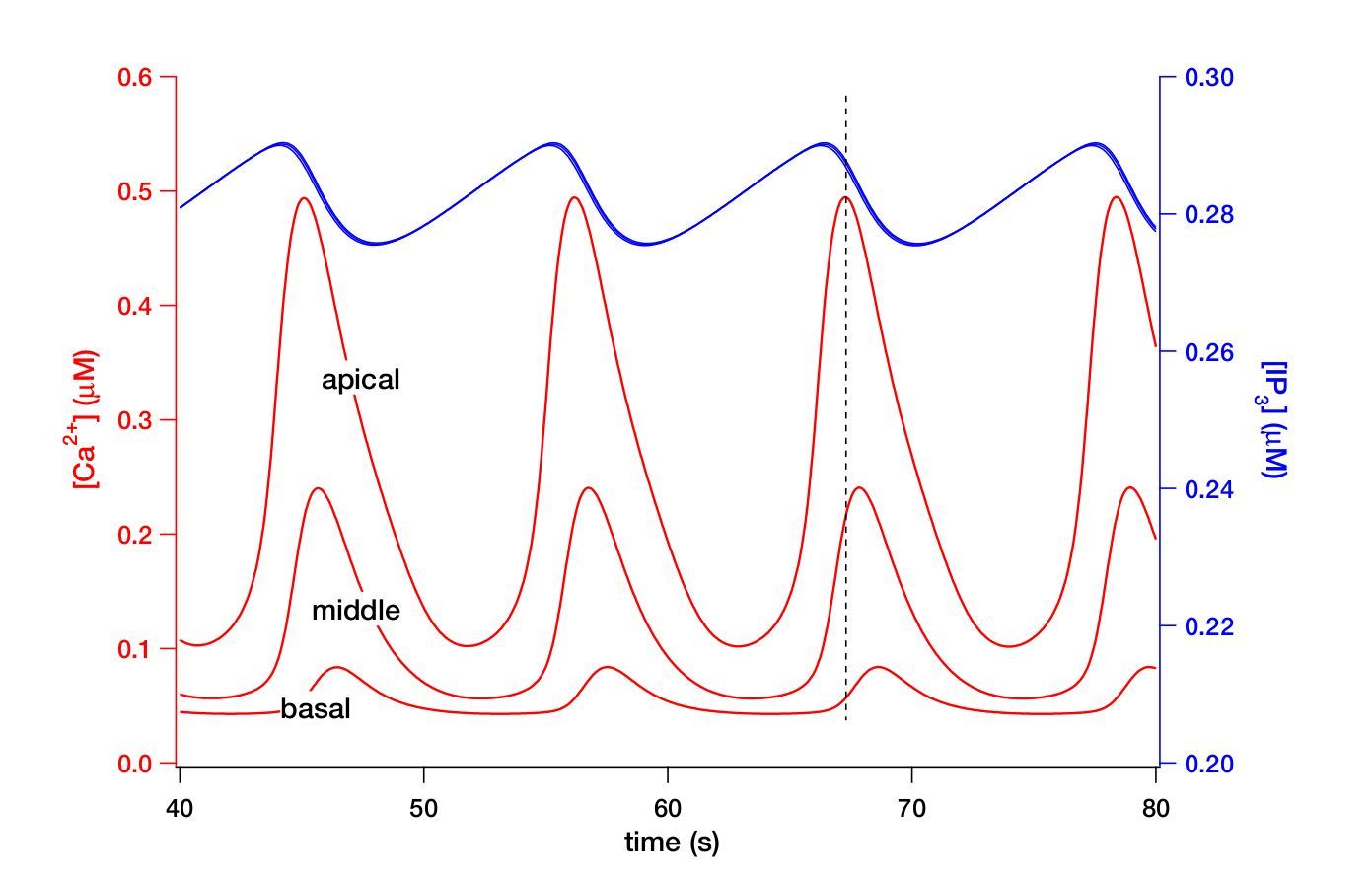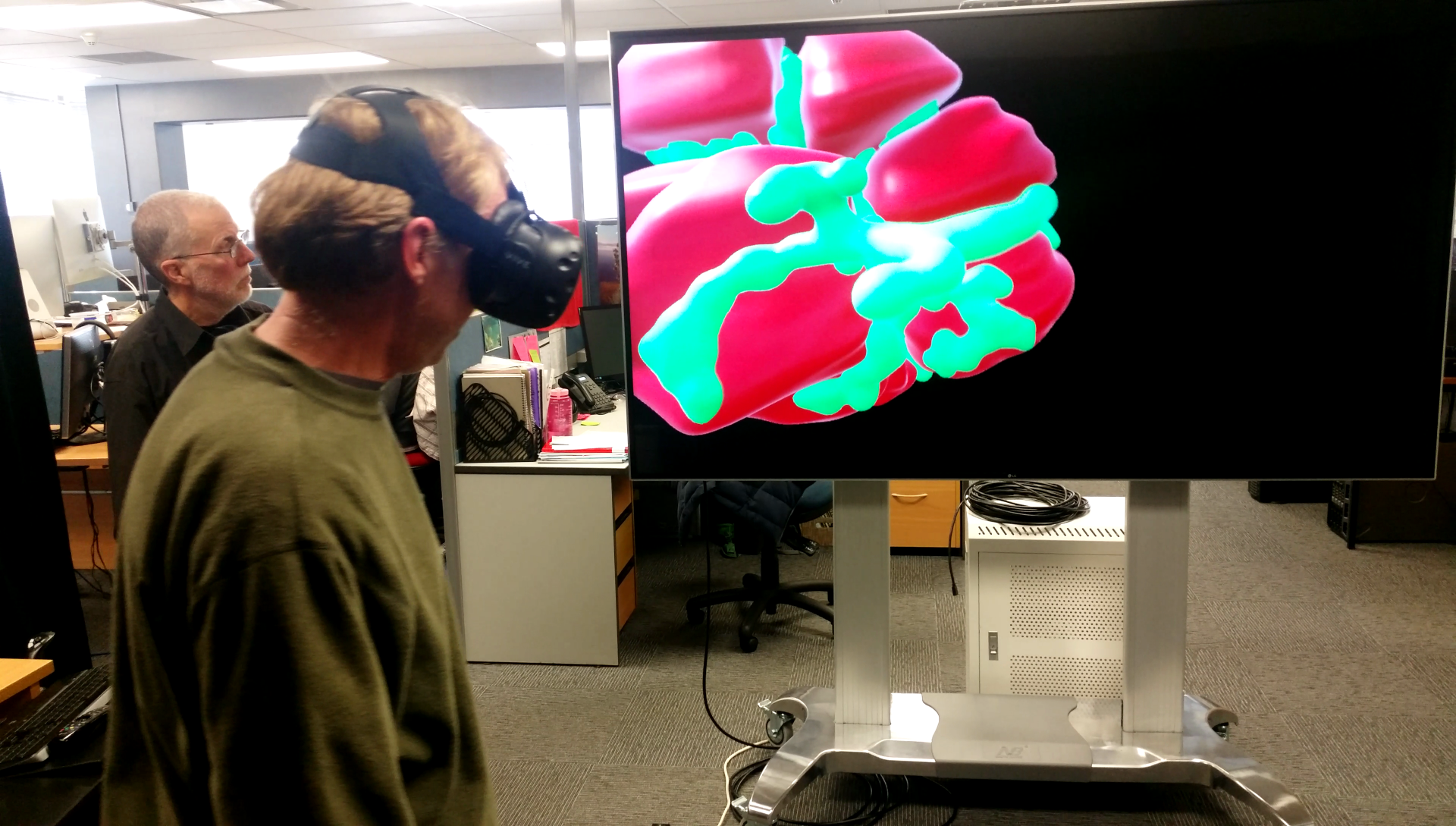
Modelling and visualisation of calcium waves in parotid acinar cells
Professor James Sneyd and Dr John Rugis, Department of Mathematics, University of Auckland
Background
The primary role of salivary gland acinar cells is to secrete saliva, the lack of which causes a host of severe medical difficulties. Thus, an understanding of the mechanisms underlying saliva secretion are vital for the understanding of oral health. Starting with experimental data, we have constructed a model of calcium waves in a three-dimensional anatomically accurate parotid acinar cell.
Computational methods
We implemented a custom simulation code in the C++ language, targeting High Performance Computing clusters, using standard FEM methods. Within our FEM implementation, the generalised minimal residual method (GMRES) was used as the main sparse matrix solver.
A typical simulation run of two thousand time steps took twelve minutes to execute on the University of Auckland Pan cluster. For selected parameter sets we ran up to ten times longer to confirm stable Ca2+ oscillations. To explore the model’s parameter space, up to one hundred different parameter sets were run simultaneously (in parallel) on the cluster.

Figure 1b. Cut-away view of the model at a time corresponding to the dashed line in Figure 1a.

Figure 1a. Simulation output plot showing Calcium and IP3 concentrations versus time.
Results
In three dimensions, with PLC making IP3 only on the basal membrane, and with a higher density of IPR in the apical region, oscillations occur, even though the site of IP3 production is spatially separated from the site of Ca2+ release, and coupled only by the diffusion of Ca2+ and IP3. A typical solution is shown in Figure left with a cut-away view shown in Figure right.
A one-dimensional model can be constructed so as to give similar amplitudes in the basal and apical regions, but cannot give a variable amplitude at a fixed distance from the basal end. Thus, we know a priori that a one-dimensional model cannot give the exact same saliva secretion as the three-dimensional model.
Visualisation
Use of the immersive virtual reality facility at the Centre for eResearch allowed us to experience walking around an over one-metre tall rendering of our model.
Reference
James Sneyd, Shawn Means, Di Zhu, John Rugis, Jong Hak Won, David I. Yule, Modelling Calcium Waves in an Anatomically Accurate Three-Dimensional Parotid Acinar Cell, Journal of Theoretical Biology, ISSN 0022-5193,
http://dx.doi.org/10.1016/j.jtbi.2016.04.030.

Dr. John Rugis guiding Prof. James Sneyd through a virtual reality experience of their model.
See more case study projects

Our Voices: using innovative techniques to collect, analyse and amplify the lived experiences of young people in Aotearoa

Painting the brain: multiplexed tissue labelling of human brain tissue to facilitate discoveries in neuroanatomy

Detecting anomalous matches in professional sports: a novel approach using advanced anomaly detection techniques

Benefits of linking routine medical records to the GUiNZ longitudinal birth cohort: Childhood injury predictors

Using a virtual machine-based machine learning algorithm to obtain comprehensive behavioural information in an in vivo Alzheimer’s disease model

Mapping livability: the “15-minute city” concept for car-dependent districts in Auckland, New Zealand

Travelling Heads – Measuring Reproducibility and Repeatability of Magnetic Resonance Imaging in Dementia

Novel Subject-Specific Method of Visualising Group Differences from Multiple DTI Metrics without Averaging

Re-assess urban spaces under COVID-19 impact: sensing Auckland social ‘hotspots’ with mobile location data

Aotearoa New Zealand’s changing coastline – Resilience to Nature’s Challenges (National Science Challenge)

Proteins under a computational microscope: designing in-silico strategies to understand and develop molecular functionalities in Life Sciences and Engineering

Coastal image classification and nalysis based on convolutional neural betworks and pattern recognition

Determinants of translation efficiency in the evolutionarily-divergent protist Trichomonas vaginalis

Measuring impact of entrepreneurship activities on students’ mindset, capabilities and entrepreneurial intentions

Using Zebra Finch data and deep learning classification to identify individual bird calls from audio recordings

Automated measurement of intracranial cerebrospinal fluid volume and outcome after endovascular thrombectomy for ischemic stroke

Using simple models to explore complex dynamics: A case study of macomona liliana (wedge-shell) and nutrient variations

Fully coupled thermo-hydro-mechanical modelling of permeability enhancement by the finite element method

Modelling dual reflux pressure swing adsorption (DR-PSA) units for gas separation in natural gas processing

Molecular phylogenetics uses genetic data to reconstruct the evolutionary history of individuals, populations or species

Wandering around the molecular landscape: embracing virtual reality as a research showcasing outreach and teaching tool
























































































































































